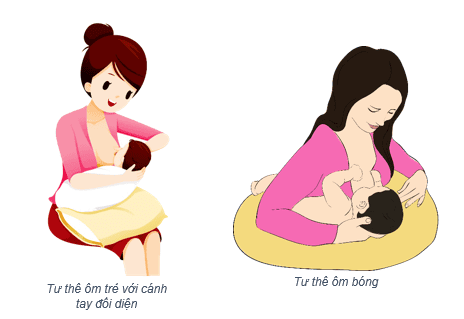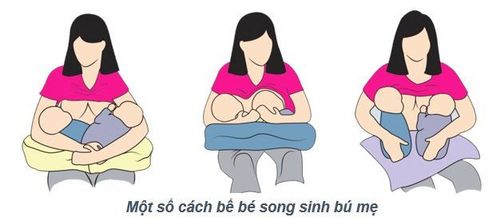This is an automatically translated article.
To breastfeed properly, mothers need to practice, learn how to hold and support the baby to create the most comfortable position while breastfeeding. This requires a lot of coordination and patience on the part of the mother.1. Crib holding position
This classic breastfeeding position requires you to hold the baby's head in your hand.Sit in a chair with supporting armrests or on a bed with lots of pillows. Place your feet on a stool or other raised surface to avoid leaning over your baby. Hold your baby on your lap (or place it on a pillow on your lap) so that your baby is lying on his side, directly facing you. If your baby is being nursed on the right breast, rest your head on your right forearm. Extend your forearms and bring your hands down your back to support your baby's neck, spine, and bottom. Hold your baby's knees firmly to your body at or just below your left breast. The baby should be horizontal or slightly tilted. Instruct the child to slightly tilt his head back so that his mouth is wide open to secure a good latching position. The best position for a full-term baby who is delivered vaginally. Some mothers report that this hold makes it difficult for the infant's mouth to direct its mouth to the nipple. So you can wait to use this position until you feel more comfortable breastfeeding, usually when your baby is 4 to 6 weeks old. Women who have had a cesarean section may find it puts too much pressure on their abdomen.
2. Cross-holding posture
Also known as the crossstand, its position differs from cradle hold in that your arms switch roles.If you are nursing from the right breast, use your left hand to support the baby's head. Bring your thumbs and fingers behind your baby's head and under his ears, pointing his mouth toward your breast. This position is best for babies, young children, and babies who have difficulty latching on.
3. Clutch or football holding arms
As the pose's name suggests, you place your baby under your arm (on the side where you're nursing) like a soccer ball or bag.Place the baby on your side, under your arm, supported by a pillow. The baby should lie on his back, nose level with your nipple. Place your arms on the pillow and support your baby's shoulders, neck, and head with your hands and forearms. Place your thumbs and fingers behind the baby's head and below the ears, directing the baby's mouth to your nipple, chin first to establish a good latch. The best position for cases if you've had a cesarean (to avoid the baby putting pressure on your stitches). If your baby is small or has trouble latching on, this hold allows you to point his or her head towards your nipple. It also works well for women with large breasts or flat nipples, and for mothers of twins who are breastfeeding at the same time.

Đây là tư thế cho con bú phù hợp nhất với trường hợp sinh mổl
4. Side lying position
While you won't see women breastfeeding in public like this, it's a common position for many breastfeeding moms when they're at home.The side position also makes it easier for you to turn if your baby falls asleep on the breast. Just be sure to move your baby to a safe sleeping space and never leave them unattended on an adult bed or couch.
Lie on your side in bed with a pillow under your head and a pillow between your knees, if you like, to keep your back and hips in a straight line. When your baby is facing you, pull her close, with her head tilted slightly back so she can open her mouth wide. Rest your head on your lower arm. If your baby needs to lie higher and closer to your breast, use your upper arm to support him, with your hand below his ear. Make sure not to put pressure on the back of the baby's head. Your baby shouldn't strain to touch your nipple, and you shouldn't bend over towards your baby. The best position is for you if you are recovering from a cesarean or childbirth, are uncomfortable sitting up, or you are breastfeeding in bed.
5. Koala pose
Once you get a hold of this, you may want to try it while your baby is swaddled against you in a soft cradle for hands-free breastfeeding. If this works for you and your child, you may never come back.Hold your baby securely upright, legs crossed over yours and head in line with your breast. The baby's head will naturally lean back when she latches on. Be sure to support the head and always keep an arm around the baby until the baby is old enough to stand on his own. The best position for babies with reflux, as feeding upright can be easier to digest. If you can master this holding in a crib, it's an ideal position for active moms.
6. Comfortable posture
Research shows that breastfeeding in a side-lying position can stimulate the suckling reflex in both mother and baby.Lie on your back in a semi-reclining position. Make sure your head and shoulders are supported. Lay your baby on his or her stomach and hold your breast with both hands. Gravity will hold the baby in the ideal position and will help deepen the latch. The best position for mothers with sore nipples or babies who have difficulty latching on. This is also a great spot for moms who want a relaxing and cuddly cuddle. You may find that this hold is quite natural for you and your baby.

Nghiên cứu cho thấy việc cho con bú ở tư thế nằm nghiêng có thể kích thích phản xạ bú ở mẹ và bé
7. Comfortable position after cesarean section
This hold helps relieve pressure from the incision while allowing you to enjoy a semi-reclining position. It may look a little funny, but since the breast is a circle, it can be approached from any side.Find a comfortable position where you can sit at a 45-degree angle and be fully supported. Place your baby over your shoulder so that his or her head is facing your breast and his mouth fits your nipple. Check to make sure that you and your baby are both snug and secure before you instruct your baby to latch on. The best position for nursing moms who want to sit back and relax after a recent caesarean section.
8. Twin feeding position
Breastfeeding means you'll make a lot of milk and need a lot of support, literally and figuratively.Place a large pillow or cushion on your lap to help you cradle both babies at the same time. If possible, have someone nearby who can transfer your child to you once you're all set up. Place one baby under each arm, their head facing your chest. Use your arms and hands to support their back and head. Make sure both babies are close to the breast for comfortable latching. The best position for breastfeeding twins. This keeping can keep you sane if you're the mother of children with binge eating.

Một số tư thế bú sinh đôi
9. Tips for every position
9.1. Support your body Choose a comfortable chair with armrests and use pillows, lots of pillows, to support your back and arms. (Most couches don't provide enough support.) Support your feet to avoid bending over your baby. A footstool, coffee table or stack of books can work. A pillow or blanket folded over your lap can also help keep you from stooping. Whichever breastfeeding position you use, make sure to bring the baby to your breast, rather than vice versa. 9.2. Support your breasts Your breasts become larger and heavier during breastfeeding. As you breastfeed, use your other hand to support your breast by holding C (four fingers on one breast and thumb on the other) or holding V (index and middle fingers at the bottom). either side of the nipple).Note: Keep your fingers behind the nipple and areola at least 5cm for the baby to fully latch on.
9.3. Support your baby Feeling comfortable and safe will help your baby nurse happily and efficiently. Use your arms and hands, along with pillows, to support your baby's head, neck, back, and hips and keep them in a straight line. In the first time, skin-to-skin is best to use a blanket to keep the baby warm when needed. Finally, you can also feed your baby while wrapping your arms at the sides.
9.4. Change your routine Experiment with feeding positions to find your favorite. The deep and comfortable latch will help you avoid sore nipples. Many women regularly alternate breastfeeding sessions to avoid blocked milk ducts. Since each latch puts pressure on a different part of the nipple, variety can also help you avoid sore nipples.
Another tip: Replace the nursing breast first in each feeding to boost milk production.
9.5. Relax Take a few deep breaths, close your eyes, and think peaceful, calm thoughts. Keep a glass or bottle of water on hand to drink while you breastfeed. Staying hydrated will help you produce milk.
9.6. When to stop breastfeeding Ideally, your baby will decide that he or she has had enough when one or both breasts are empty. If you need to remove your baby from the breast while feeding, gently bring your finger to the corner of his mouth, touching the center of his gums to break the suction.
9.7. Try not to sleep while breastfeeding Breastfeeding helps protect your baby against sudden infant death syndrome (SIDS). However, the AAP recommends that you don't sleep with your baby because you could roll over him. If you think you might fall asleep while breastfeeding, feed your baby in bed rather than on a sofa or booster seat, which is more dangerous as the baby could get caught between the mattress.

Nuôi con bằng sữa mẹ giúp bảo vệ con bạn chống lại hội chứng đột tử ở trẻ sơ sinh (SIDS)
Newborns in general are prone to respiratory diseases, respiratory infections and gastrointestinal infections if they are introduced to solid foods early or the storage and preparation of milk is not guaranteed. To protect children's health, parents should do well to exclusively breastfeed their babies for the first 6 months (if possible) and vaccinate on schedule. As soon as the child shows symptoms such as anorexia, fatigue, crying, it is necessary to take the child to the hospital to be consulted by a specialist for monitoring and treatment. The pediatric department at Vinmec International General Hospital is the address for receiving and examining diseases that infants and young children are susceptible to: viral fever, bacterial fever, otitis media, pneumonia in children. With a system of facilities, modern medical equipment, sterile space, minimizing the impact as well as the risk of disease spread, Vinmec will bring satisfaction to customers. and is highly appreciated by industry experts with:
Gathering a team of leading pediatricians: including leading experts with high professional qualifications (professors, associate professors, doctors, Master's degree), experienced, worked at major hospitals such as Bach Mai, 108.. The doctors are all well-trained, professional, conscientious, knowledgeable about young psychology. In addition to domestic pediatric specialists, the Department of Pediatrics also has the participation of foreign experts (Japan, Singapore, Australia, USA) who are always pioneers in applying the latest and most effective treatment regimens. . Comprehensive services: In the field of Pediatrics, Vinmec provides a series of continuous medical examination and treatment services from Newborn to Pediatric and Vaccine,... according to international standards to help parents take care of their baby's health from birth to childhood. Advanced techniques: Vinmec has successfully deployed many specialized techniques to make the treatment of difficult diseases in Pediatrics more effective: neurosurgery - skull surgery, stem cell transplantation blood in cancer treatment. Professional care: In addition to understanding children's psychology, Vinmec also pays special attention to the children's play space, helping them to play comfortably and get used to the hospital's environment, cooperate in treatment, improve the efficiency of medical treatment.
Please dial HOTLINE for more information or register for an appointment HERE. Download MyVinmec app to make appointments faster and to manage your bookings easily.
Reference source: babycenter.com












